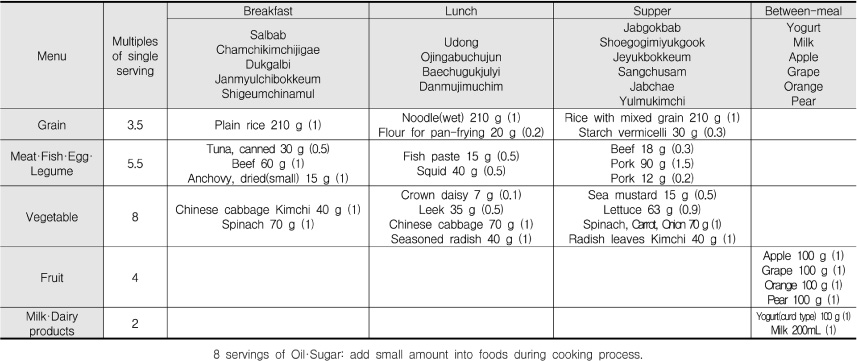Nutritional Adequacy Analysis of Recommended Menu in Dietary Reference Intakes for Koreans 2015
Article information
Abstract
Objectives
Recommended Menu (RM) prepared according to the Target Pattern expected to meet the dietary reference intake (DRI) of nutrients. Nutritional adequacy of RM in ‘DRI for Koreans 2015’ were analyzed to verify whether such expectation was fulfilled.
Methods
Dishes in RM are categorized by 5 food groups, and number and types of dishes for main meal and between-meals were analyzed. The energy and 12 nutrients (protein, dietary fiber, Ca, P, Fe, Na, K, vitamin A, thiamin, riboflavin, niacin and vitamin C) contents in 10 RMs were calculated using the food composition table (CD) in ‘DRI for Koreans’. Energy, energy contribution ratio, and nutrient contents in 10 RMs for 18 age groups were evaluated based on the ‘DRI for Koreans 2015’.
Results
Number of dishes per meal were 4.83, and representative table setting consisted of cooked rice + soup (or stew) +3 side dishes. Energy contents of RM were 75~109% of estimated energy requirement (EER). None of the RM met the DRI of all 12 nutrients examined. Calcium was the most insufficient nutrient. Only 1-2 years' RM met the DRI, all the other RMs did not meet the calcium DRI. Dietary fiber and potassium contents were also insufficient in most RM. In adult male's RM, only 1 nutrient, i.e. calcium did not meet the DRI, but in female adult's RM, 5~6 nutrients did not meet the DRI. Energy contribution ratio of carbohydrate, protein, and fat in RM were 59.0~70.4%, 15.7~17.5%, 12.1~23.5%, respectively. And 4 RMs out of 10 exceeded the upper limit of acceptable macro-nutrient distribution range (AMDR) of carbohydrate and 3 RMs out of 10 RM were below the lower limit of fat AMDR. Contribution ratio of nutrients were ≥ 40% by food groups were as follows: grain group in energy and carbohydrate; meat·fish·egg·legume group in fat, protein, and niacin; vegetables group in dietary fiber, vitamin A, and vitamin C; milk·dairy products group in calcium.
Conclusions
RM prepared according to the Target Pattern did not meet nutritional adequacy as expected. Especially calcium, potassium, and dietary fiber contents are needed to be increased in many RMs. Further, energy content in RM needs to be adjusted for fat·sugar food group assigned in Target Pattern and condiment.









